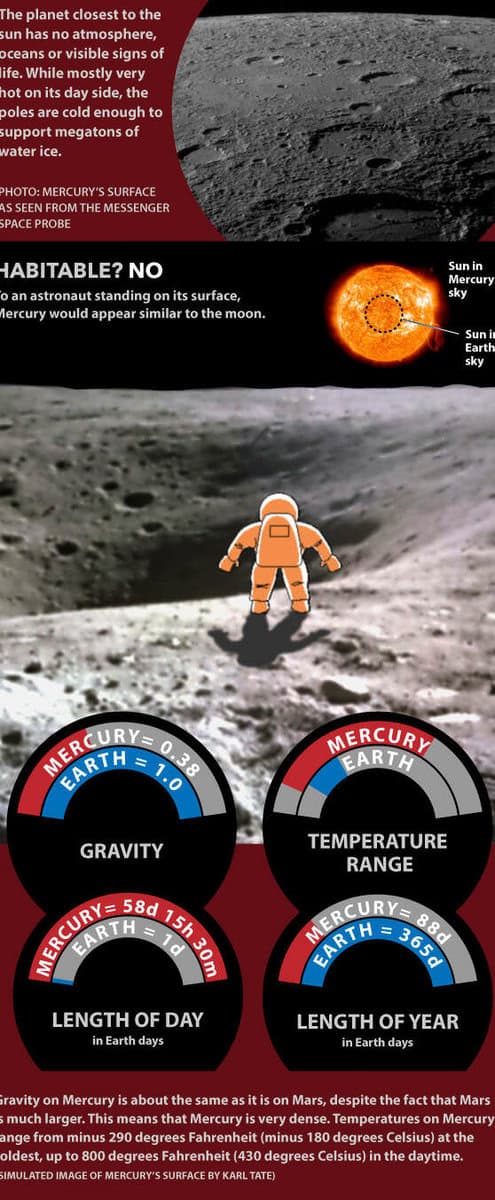The concept of establishing colonies on Mars has been a topic of discussion for quite some time now, with actual progress being made towards this goal. After all, the Red Planet is relatively proximate to Earth and bears some resemblance to our home planet. However, when it comes to Mercury, the situation is entirely different. In this article, “Hitech” explores the viability of inhabiting this planet and the reasons behind such a venture.
Explore “Haytek” on
The concept of residing and working on Mercury may appear implausible, a plot derived from the realm of science fiction. Nevertheless, this idea is rooted in scientific realities – with the appropriate technology and life-support systems, human habitation on this planet is plausible. By implementing the right strategies, inhabitants could even sustain themselves. One potential avenue for economic development is centered around “adventure tourism,” in addition to mining and harnessing energy resources. Mercury boasts abundant deposits of minerals and precious metals, and its close proximity to the Sun grants access to an immense amount of solar energy. However, before an economy can be established, it is imperative to comprehend the challenges of surviving in this hostile environment. Here are the obstacles that must be overcome.
Unusual temperature extremes
Despite being the closest planet to the Sun, Mercury is not the hottest planet, as that title belongs to Venus. The key point here is that Mercury has never had and currently does not have a substantial atmosphere, apart from a thin exosphere. This exosphere consists primarily of atomic oxygen and hydrogen, along with trace amounts of sodium, magnesium, helium, and other minerals. However, the atmospheric pressure on Mercury is extremely low, not exceeding 5 x 10-15 bar (0.005 picobars). To put this into perspective, it is one trillionth of Earth’s atmospheric pressure at sea level. As a result, Mercury does not retain heat from the Sun and experiences significant temperature fluctuations. What does this mean? The side facing the Sun can reach scorching temperatures of up to 427 °C, while the “night” side cools down to a frigid -173 °C. Moreover, due to its orbit, these extreme day and night temperatures can persist for months on end. Speaking of its orbit, Mercury has one of the most eccentric orbits in the entire Solar System. Its elliptical shape causes the distance from the planet to the Sun to vary from 46 million kilometers at perihelion to 70 million kilometers at aphelion.
The planet’s close proximity to the Sun causes its orbital period to be significantly longer. Consequently, a year on Mercury passes at a rapid pace, lasting only 88 Earth days. Within this time frame, the planet manages to complete one full orbit around the Sun. Simultaneously, a day on Mercury spans 58 Earth days. Due to its close proximity to the Sun, Mercury is subjected to extremely intense radiation. This implies that even if individuals were able to devise methods for protecting themselves from extreme temperatures, exposure to sunlight on Mercury would still prove fatal. Therefore, settlers would be required to avoid direct sunlight at all times. Scientists have developed a few concepts in response to this challenge.
Ways to endure on Mercury?
According to the findings and information gathered by the MESSENGER probe, it has been discovered that Mercury, much like the Moon, possesses lava tubes. These structures are remnants of the planet’s previous geological activity. A few of these lava tubes are even spacious enough to accommodate an entire city.
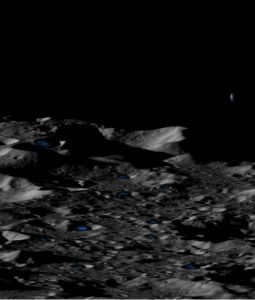
The lava tubes provide a stable and optimal temperature for comfortable living (22±1 °C). Additionally, they offer protection from radiation, which is especially beneficial considering the lack of atmosphere. Interestingly, it is possible to create an artificial Earth-like atmosphere by combining nitrogen and oxygen in a ratio of 78:22 in sealed conditions beneath the Earth’s surface.
Alternatively, mobile settlements could be established, constantly moving westward and residing on the border between day and night. Due to Mercury’s slow rotation and fast orbit, one side of the planet experiences 176 days of continuous daylight, eliminating the need for settlements to move quickly.
On the other hand, a possibility arises to establish a settlement in regions that are constantly shaded, such as the northern pole of Mercury, which is covered in craters. In these areas, temperatures are sufficiently low for the existence of water ice. The largest craters – Prokofiev, Chesterton, Kandinsky, and Tryggvadottir – are quite substantial, varying in size from 31 kilometers to 112 kilometers. This size is adequate for a small town or potentially even a metropolis.
Furthermore, the MESSENGER probe’s collected data revealed that these craters might contain between 110 billion and 1.1 trillion tons of water ice. This ice could be extracted to fulfill the water requirements of the colonists, while solar panels positioned along the rim of the crater would offer a constant energy source. Additionally, sunlight can be directed into the craters using mirrors, which means that agricultural activities could theoretically be possible.
By utilizing the concept of paraterraforming, originally introduced by Richard Taylor, a mathematician from the United Kingdom, in 1992, it becomes feasible to create a self-contained environment within the craters in order to establish an artificial closed atmosphere.
What makes exploring Mercury worthwhile?
Mercury receives 6.5 times more solar radiation than Earth. With the deployment of a fleet of solar-powered satellites, this planet can serve a multitude of purposes beyond sustaining human life on its surface. Currently, scientists and engineers are actively researching space-based solar power as a potential solution to combat climate change.
An intricate network of satellites orbiting Mercury could amass a substantial amount of solar energy. This energy could then be transmitted to the Earth-Moon system and other destinations through the use of microwave lasers. Thus, Mercury could be regarded as the ultimate “power plant” within our solar system.
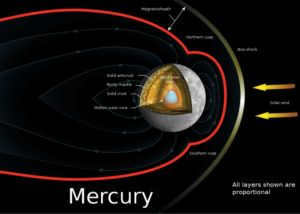
Mercury is known for its vast reserves of valuable metals and minerals. Similar to its neighboring rocky planets (Venus, Earth, and Mars), Mercury is primarily composed of silicate minerals and metals. Its structure consists of a silicate mantle and a crust that encases a metallic core, primarily made up of iron-nickel alloy.
According to recent geological findings, it has been determined that the crust is approximately 35 km thick, while the mantle is estimated to be around 600 km in thickness. The metallic core, on the other hand, has a diameter of approximately 4,148 km. This means that the central region of the planet accounts for about 85% of its overall size. Meanwhile, the surface of Mercury is notably rich in magnesium and sulfur, and over the course of the solar system’s history, it has accumulated vast deposits of minerals and precious metals, brought to the planet by asteroids and meteors.
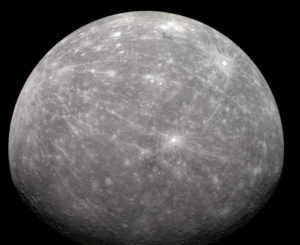
Mercury has another advantage in terms of its gravity. Despite being the smallest planet in the Solar System and even smaller than some moons (for example, Jupiter’s moon Ganymede), its surface gravity is similar to that of Mars – around 38% of Earth’s gravity. Extensive research, such as the Twins Study, has revealed the negative effects of microgravity on the human body, including muscle and bone loss, impaired vision, circulation, cardiovascular issues, and organ function. The lower gravity on Mercury would also make it relatively cost-effective to launch payloads or spacecraft from its surface.
Mercury is among the potential candidates for future colonization within our solar system, alongside Mars, Venus, the Moon, Ceres, Europa, Ganymede, Callisto, and Titan. Perhaps future generations will consider Mercury as a possible home.
For further information, please click here


Ever since mankind first ventured into space, scientists have been intrigued by the possibility of discovering extraterrestrial life on other planets within our solar system. The question of whether there is life on Mercury has particularly piqued their interest.
Being the closest planet to the sun, Mercury holds immense fascination for researchers due to its seemingly infinite energy reserves.
Furthermore, the installation of telescopes would provide scientists with more precise data regarding solar activity, such as magnetic storms and prominences.
The launch of the Mariner 10 and Messenger spacecrafts did not provide any evidence of the presence of living organisms on the planet Mercury. However, scientists have continued their research to investigate the potential for life in such extreme conditions. This exploration is crucial for addressing challenges related to future colonization efforts on the planet.

Is there potential for life?
Despite the presence of oxygen, methane, and water vapor in the atmosphere of Mercury, scientists believe that it is unlikely for living organisms to have ever existed here.
- The low levels of oxygen would hinder the body’s ability to produce sufficient energy.
- There is no liquid water on the planet. Although there are large amounts of water ice in the craters, it remains frozen due to the lack of sunlight.
- The extremely high temperatures on Mercury, reaching up to 430 °C, make it inhospitable for living organisms.
- Mercury experiences extremely low atmospheric pressure, approximately 5*10 -11 times less than the pressure on Earth. This results in the most drastic temperature fluctuations in the entire solar system, ranging from -200 to +430 degrees. At the poles, known as the “eternal day” zones, temperatures can reach +430 degrees. In the dark hollows, also known as the “eternal night” zones, temperatures do not exceed -200 degrees. These sharp temperature changes contribute to a loose surface that does not conduct heat well within the planet. As a result, the heated surface of Mercury quickly cools down.
The low pressure on Mercury’s surface causes it to be bombarded by the solar wind, which is composed of charged particles such as hydrogen ions, helium ions, and heavy metals.
When charged particles collide with the surface of the planet at a velocity of 400-800 km/s, they cause the destruction of the outer layer, dislodging atoms of sodium, magnesium, potassium, calcium, and other elements from the ground. These dislodged atoms then come together to create an exosphere surrounding Mercury.
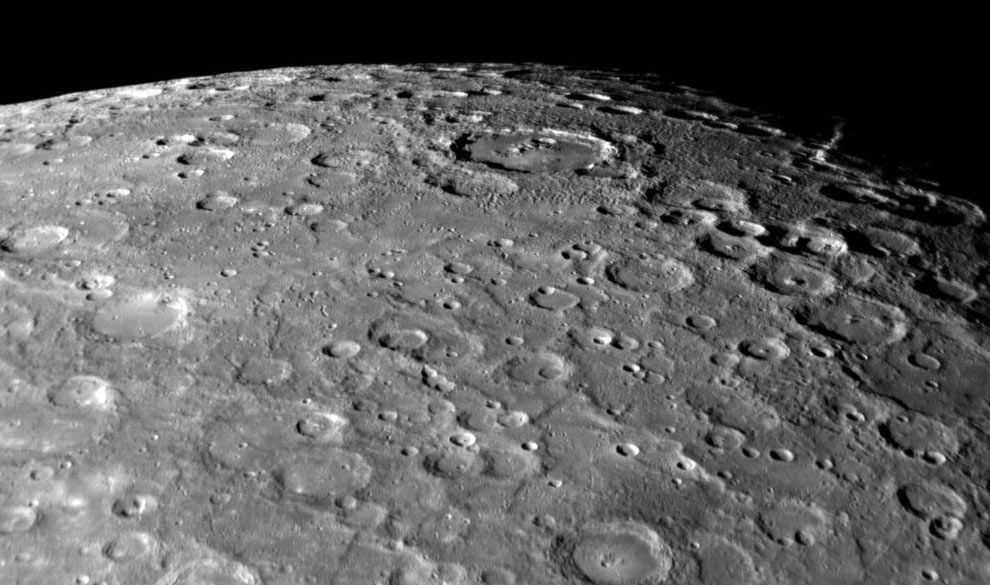
The suggested site for the establishment of the Mercury base
There are multiple potential locations for the establishment of the base on the planet. In theory, it could be positioned in the regions that experience perpetual daylight. However, this would require the installation of robust barriers, mirrors capable of reflecting and deflecting a substantial portion of solar radiation, including gamma radiation.
In order to explore Mercury, astronauts would require rovers equipped with formidable shielding against solar radiation. This alternative is both financially and energetically demanding.
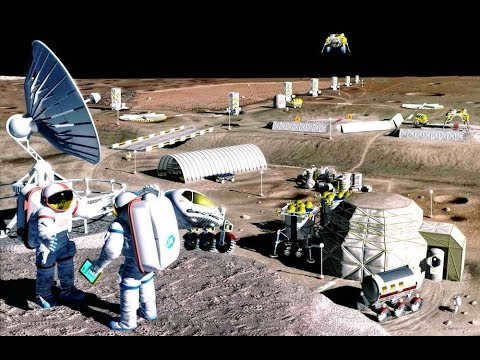
The optimal solution is to situate the base in the regions of perpetual darkness, shielded from solar radiation, and rich in water ice reserves for exploitation. However, the extremely frigid temperatures present challenges for human habitation at the poles.
According to David Blewett, a scientist involved in the Messenger program, it would be more favorable to establish the base near the ice caps of the craters, where temperatures are not as severe.
For several years now, NASA has been contemplating the establishment of a colony within the underground lava tubes believed to exist on Mercury. In 2011, the Messenger spacecraft detected peculiar cavities on the planet’s surface, indirectly supporting the existence of subterranean lava tubes.
By constructing tubes like these, the resulting colony would be shielded from drastic temperature fluctuations as well as the harmful effects of solar and cosmic radiation. Once the tubes reach a depth of 1m, the temperature stabilizes at a comfortable 75°C. Moreover, it is possible to seal off the tubes in the lava to create a livable atmosphere for the inhabitants.

Challenges of Establishing a Colony on Mercury
The colonization of Mercury poses a number of challenges due to its remote location from Earth and its proximity to the Sun. The primary difficulties are associated with the journey itself. In terms of resources and energy requirements, a mission to Mercury is comparable to a mission to Pluto. The spacecraft would need to perform at least six gravity maneuvers.
While advancements in space engine design could potentially overcome the challenges of the journey, the inhospitable conditions for human habitation cannot be altered.
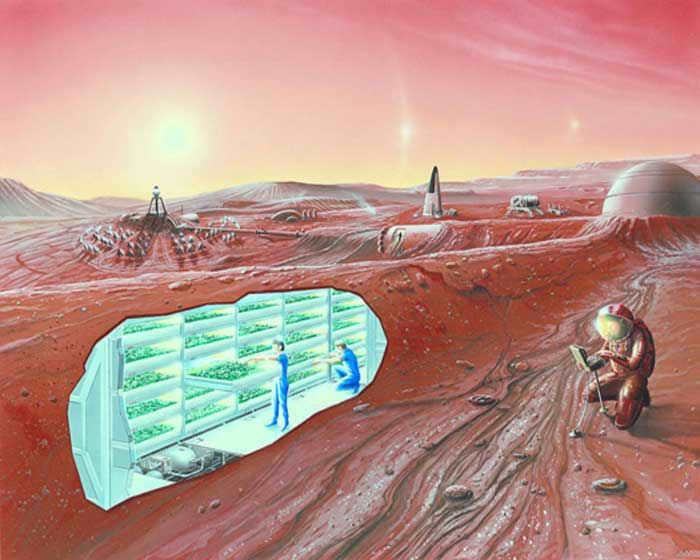
Contrary to the conditions on Earth, the natural environment on Mercury will have a detrimental impact on the well-being of astronauts who plan to settle there. The absence of an atmosphere means that they will have to spend a significant amount of time in confined spaces, whether it be lava tubes or enclosed domes. This confinement will have an adverse effect on the psychological health of the entire team and the overall emotional atmosphere. Additionally, the disruption of biological rhythms due to the long Mercurian day (which lasts 178 Earth days) will negatively affect their mental health.
Water is a crucial element for life on Earth, and scientists are particularly interested in the abundant reserves of ice located at the poles of Mercury. By studying the origins of this ice, researchers hope to uncover evidence that suggests the possibility of past life on this dwarf planet. While some speculate that life may have existed on Mercury in the past, further investigations are needed to confirm this hypothesis.
The planet Mercury has been recognized by humans for thousands of years. The earliest record of its existence dates back to the 16th century B.C. in an ancient Babylonian astrological compilation known as the Mul apin. Over time, Mercury has been known by various names. The Sumerians referred to it as the “jumping planet” in the Mul apin, while the Greeks called it Hermaeon and Apollo. Ultimately, the planet acquired its official name from the ancient Romans, who named it after Mercury, the swift god associated with commerce, due to its faster movement across the sky compared to other planets.
Important details about Mercury
Mercury happens to be the nearest planet to the Sun. The distance between Mercury and the star measures 58 million kilometers. Moreover, Mercury holds the title for being the smallest planet in the Earth group. Its radius measures 2440 km, which is smaller than the radius of Titan and Ganymede, the moons of Saturn and Jupiter. Despite its size, the planet carries a significant mass of 3.3*10 23 kg, which is attributed to its massive core.
Mercury possesses an average density, slightly lower than that of the Earth and measuring at 5.43 g/cm 3 . This suggests a high concentration of metals in its structure, considering the Earth’s larger size.
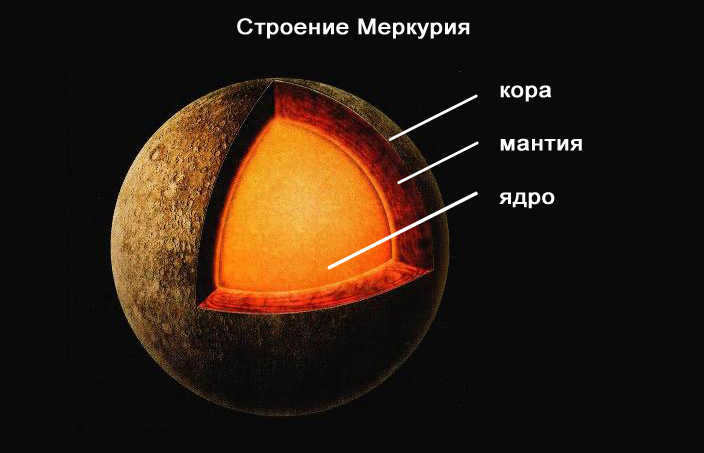
The gravitational acceleration on Mercury is approximately half that of Earth, measuring at 3.70 m/s 2 .
Similar to Venus, Mercury does not possess any natural satellites.
Physical characteristics of Mercury
The planet exhibits a variety of unique features in its composition.
According to scientific theories, these features were formed as a result of a collision with remnants from the early stages of the solar system’s formation.
The shape and size of the craters vary, with some being deep and multi-ringed while others are small depressions. Mercury has fewer large craters compared to Earth’s moon. The largest crater is the Heat Plain basin, measuring 1315 km in height and 1550 km in diameter. The presence of these large craters suggests that there has been no tectonic activity in Mercury’s crust for the past 4 billion years.
Over time, the craters on Mercury’s surface gradually erode. On well-preserved craters, one can observe rock rays that were displaced by the impact of a celestial object.
Certain areas on the planet’s surface have a higher concentration of craters, indicating their ancient origin, while other areas have fewer craters and are younger, formed as a result of lava flooding.
These two characteristics are in conflict with each other. The presence of plains, or lava fields, suggests that there was volcanic activity on the planet in the past. However, the number and age of the craters indicate that Mercury has been geologically inactive for a long time.
- There are numerous jagged ridges that stretch for hundreds of kilometers and reach heights of up to two kilometers.
Scientists do not agree on the origin of these ridges. According to one perspective, the ridges were formed as a result of crustal bulges caused by tectonic activity. While on Earth, such bulges occur during the movement of tectonic plates, on Mercury, crustal extrusion happens due to gradual compression of the core.
There is a second perspective on the theory of ridge formation. Some researchers propose that the ridges originated from impacts by asteroids.
A unique aspect of Mercury is that the majority of its surface exhibits a uniform structure, as indicated by data acquired during the Messenger mission. In contrast, the Moon and Mars, despite having similar external structures, possess distinct left and right hemispheres.
Chemical composition
The initial information regarding the chemical makeup of Mercury was obtained during the messenger mission in 2011. Spectrometry was utilized to analyze the upper layers of the soil across a 5 million square meter area. This analysis revealed elevated levels of Ca/Si, Mg/Si, and S/Si ratios, while demonstrating lower concentrations of Al/Si. Essentially, Mercury’s surface is predominantly composed of magnesium, calcium, and sulfur, with a minimal presence of aluminum.
Internal Configuration
The internal configuration of Mercury is characterized by a tri-layered structure comprising of a core, mantle, and crust.
Based on data gathered by the Messenger spacecraft, the crust measures approximately 26±11 km in thickness.
The mantle, primarily composed of silicates, has a thickness of 500 km.
The core, which accounts for approximately 83% of the planet’s total mass, is considerably massive. It exists in a liquid state and is composed of a molten blend of iron and nickel. The iron concentration in the core surpasses that of any other planet’s core.
Composition of Mercury’s Atmosphere
Mercury’s atmosphere is incredibly thin and has a pressure of 10 -15 bar, which is approximately 5*10 23 times less than the pressure on Earth. The atmosphere of this planet consists of various elements:
- Oxygen – 42%;
- Sodium – 29%;
- Hydrogen – 22%;
- Helium – 6%;
- Potassium – 0.5%;
- Other substances – 0.5% (including carbon dioxide, water, calcium, magnesium, nitrogen, xenon, argon, neon, krypton).
The presence of numerous substances can be attributed to the influence of the solar wind, which consists of plasma ions of helium and hydrogen. When these particles collide with great force, they dislodge atoms of sodium, potassium, calcium, and magnesium from the surface, causing the topsoil to become loose. Some of the plasma ions are propelled back into space, while others are captured by Mercury’s magnetosphere. The entry of argon into the atmosphere is a result of the radioactive decay of potassium, which is caused by the low plasma flux. Additionally, water vapor is produced through the reaction between ground oxides and hydrogen from the solar wind, as well as through the melting of ice in the craters.
An atom within Mercury’s atmosphere has a lifespan of approximately 200 days. Despite the presence of gravity and a magnetic field, the gases easily disperse into outer space.
Mercury’s orbit around its star is in the form of an elongated ellipse, with aphelion being 70 million kilometers away from the Sun and perihelion being 46 million kilometers away. This means that in the aphelion phase, Mercury is 1.5 times farther from the star than in the perihelion phase.
The orbital period of Mercury is 88 days on Earth. It was previously believed that Mercury did not rotate on its axis. However, radar observations in the 1960s revealed that it actually completes 1.5 rotations on its axis for every revolution around the Sun. This is a unique characteristic among the planets in our solar system. As a result, a solar day on Mercury lasts for 2 Earth years.
Mercury revolves around itself at a velocity of 48 km/s. The planet’s axial rotation maintains a constant speed, while its revolution around the Sun experiences varying speeds. During 8 days at perihelion, the orbital angular velocity surpasses that of the axial rotation – 56.6 km/s at perihelion and 38.7 km/s at aphelion. It’s as if the Sun halts and then starts moving not westward, but eastward. Astronomers have dubbed this phenomenon the Joshua effect, named after a biblical character who prophesied the Sun’s halt.
Unlike Earth, Mercury does not undergo seasonal changes. This is due to the orientation of its rotational axis, which is tilted at a 90-degree angle to the orbital plane. As a result, there are polar regions where the Sun’s rays shine horizontally. In these areas, perpetual winter is observed.
Natural conditions
Mercury undergoes extremely dramatic temperature fluctuations in comparison to other celestial bodies within our solar system. This phenomenon can be attributed to the following contributing factors:
- The planet’s sluggish rotation on its axis.
- Its close proximity to the Sun.
- A sparse atmosphere.
- A worn-down surface that lacks efficient heat conduction within the planet.
During the daylight hours, the average temperature on Mercury reaches 350°C, while plummeting to -170°C during the nighttime. At its “hot longitude” during perihelion, the planet has experienced a peak temperature of 427°C, with the lowest temperature recorded being -183°C.
Mercury possesses vast reserves of water in the form of ice situated at the depths of craters. This ice remains solid due to the absence of solar heat. Scientists are highly intrigued by its origin. The existence of water on the planet suggests the possibility of life.
The Magnetic Field
The magnetic field of Mercury is generated by dynamic effects occurring in its core as a result of the circulation of molten iron. Similar to our planet, the magnetic field is dipole in nature, with both south and north poles. However, its strength is approximately 100 times weaker than that of Earth. The magnetic field is deflected 480 kilometers northward under the influence of the low-plasma wind. Consequently, the south pole is more exposed to cosmic radiation compared to the north pole.
The magnetic field of the planet interacts with the solar wind, resulting in the capture of streams of low-energy plasma and the creation of numerous vortices. In 2008, vortices were observed by the Messenger instruments, which are nodes of intertwined magnetic field lines connecting the spacecraft to the planet’s magnetic field. The frequency of these vortices occurring on Mercury is 10 times higher compared to Earth.
Consequently, the planet’s electromagnetic field contains multiple regions (“windows”) with low strength. These “windows” allow plasma particles carried by the solar wind to reach the surface.
The primary hypothesis for the origin of Mercury is the Nebular hypothesis. According to this hypothesis, the dwarf planet formed from a cosmic nebula.
Another hypothesis suggests that Mercury was once a satellite of Venus and later separated from it to become a planet. In the 1970s, Tom Van Flander and C.R. Harrington conducted mathematical calculations that supported this theory. They showed that it is quite plausible as it explains the resonant nature of Mercury’s rotation around the Sun, its elongated orbit, and the loss of rotational momentum.
Scientists are just as concerned about the formation of an exceptionally large core as they are about the planet’s development. An explanation for this phenomenon has been proposed, suggesting that it was the result of a collision with a celestial object. In the past, Mercury had a weight that was 2.25 times greater and a higher silicate content. During a collision with a smaller celestial body, which had a mass six times less than Mercury, the heavy metallic core remained intact, while the mantle and crust lost a substantial amount of material that was ejected and dispersed into space.
Another theory suggests that Mercury originated from a protoplanetary object, specifically its inner region. This region was subjected to the solar wind and radiation, leading to the gradual depletion of lighter chemical elements. This depletion could explain the relatively low ratio of light elements to heavy elements in Mercury’s composition.
Research on Mercury Persists
In October of this year, the Bepicolombo spacecraft was launched to explore Mercury. This mission is a collaboration between the space agencies of Japan and Europe. The two spacecraft will operate in different orbits to conduct their investigations:
Both spacecraft are equipped with a multitude of exploration instruments provided by various countries involved in the project, including Russia. The Bepicolombo project aims to examine the internal structure and surface composition of Mercury, investigate its geological past, analyze the interaction between its magnetic field and the solar wind, and map the polar regions to identify the presence of water ice and hydrogen-containing compounds.
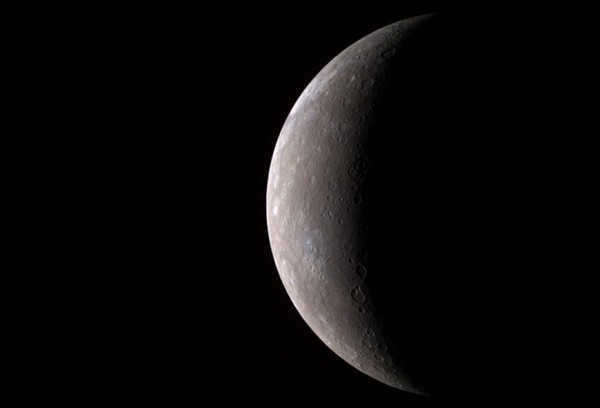
Despite being a member of the terrestrial group of planets, Mercury remains the least studied planet in this group. While more than 40 spacecraft have explored Venus, only two have explored Mercury. So, what else should you know about the first planet in our solar system?
Here are 10 fascinating facts about Mercury:
1) Since 2006, Mercury has held the title of the smallest planet in the solar system (previously held by Pluto, which is now classified as a dwarf planet). Mercury is only slightly larger than the Moon. To put it into perspective, if the Sun were the size of a standard front door, Earth would be about the size of a nickel coin and Mercury would be about the size of a green pea.
2) The planet known as Mercury, which is named after the ancient Roman god of commerce and is known for its swiftness, is the planet closest to the Sun. It is located about 58 million kilometers away from our Sun.
3) A day on Mercury is equivalent to 59 Earth days, which is the amount of time it takes for the planet to complete one rotation on its axis. A year on Mercury is equal to 88 Earth days, which is the time it takes for the planet to complete one revolution around the Sun. Interestingly, during its two revolutions around the Sun, Mercury completes three rotations around its own axis.
4) Mercury is part of the group of planets that includes Earth. It shares similarities with Earth’s natural satellite not only in terms of size, but also in terms of its physical characteristics. The surface of Mercury is heavily cratered.
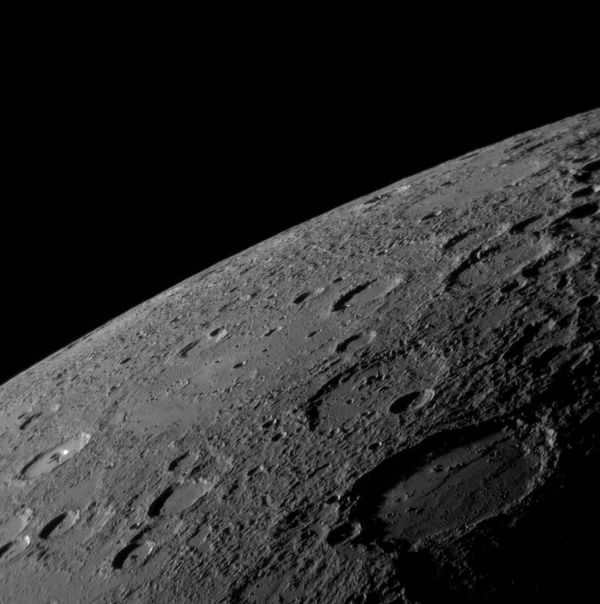

5) The composition of Mercury’s atmosphere is primarily made up of oxygen, sodium, hydrogen, helium, and potassium, and it is extremely thin and rarefied.
6) There are no satellites or rings around Mercury.
7) Mercury is often referred to as the least explored planet in our solar system. Only two spacecraft have had the opportunity to “visit” this planet. The first was Mariner 10, which made three flybys of Mercury between 1974 and 1975. The second was Messenger, which entered into orbit around Mercury in 2011.
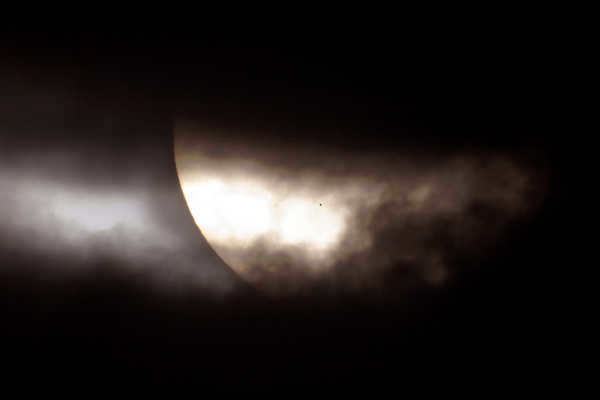
(Mercury can be seen as a small spot in the background of the Sun)
8) Scientists have not found any evidence of life on Mercury. The extreme surface temperatures on the planet, which can reach 430°C during the day and drop to -180°C at night, make it completely inhospitable.
9) The Sun appears three times larger from Mercury’s surface compared to Earth’s surface.
10) If Earth were the size of a baseball, Mercury would be the size of a golf ball.


There is a theory proposing that Mercury is the solid inner part of a previous gas giant.
It is awe-inspiring to comprehend the vastness of this celestial body.
photo – the celestial body in the backdrop of the Sun is Mercury.
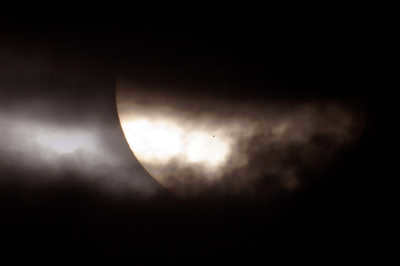
The bay in Cape Cod, Massachusetts is illuminated by the majestic appearance of the Milky Way.

Transformations of Mars during dust storms

The Lebanon Mountains at Sunset, with the Moon, Venus, and Jupiter.
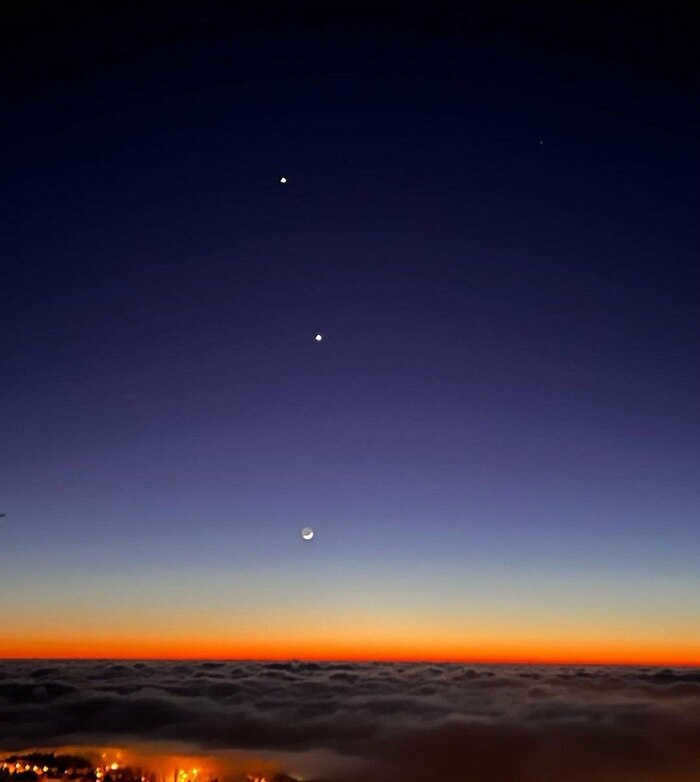

A brilliant meteor originating from the Northern Taurids stream
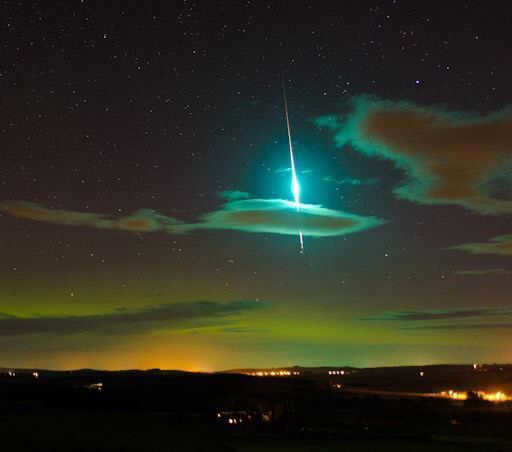
The annual Taurids meteor shower can be observed from September to December and can be found in the Taurus constellation.
The Taurids meteor shower is connected to Comet Encke and consists of meteor particles that have separated from the comet in the past. Over time, the orbits of these particles have changed, causing them to intersect with the Earth’s orbit.
Signs of a Catastrophe on Mars, yet Two Clues Indicate Mars is Still Thriving
Based on the images transmitted from Mars’ automated interplanetary stations and rovers, it is evident that a widespread catastrophe occurred on the planet, resulting in the eradication of all life forms. However, it is believed that Mars once harbored life due to the abundance of water present, as indicated by the presence of riverbeds and the remnants of colossal floods. Furthermore, the unique terrain on Mars is a direct result of erosion caused by water.
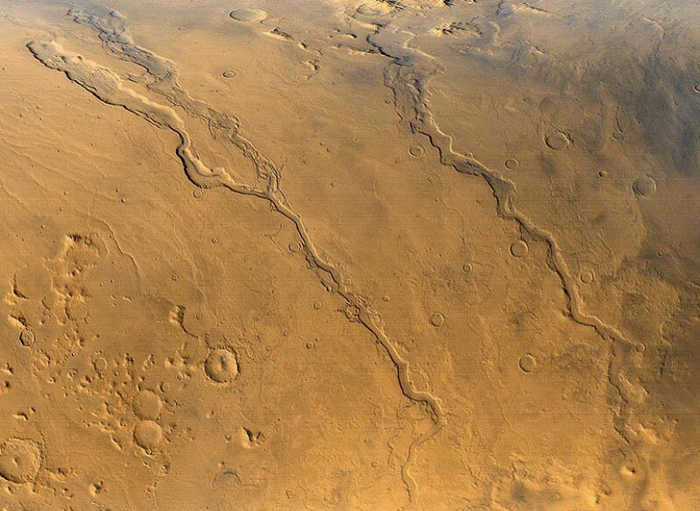
A region characterized by a water flow pattern spanning approximately 100 kilometers.
It is possible that these features are not typical rivers but instead heavily eroded fault lines. Alternatively, they could be streams originating from mud volcanoes. However, further details will be provided later on.
The most conspicuous evidence of the events that transpired can be observed here.
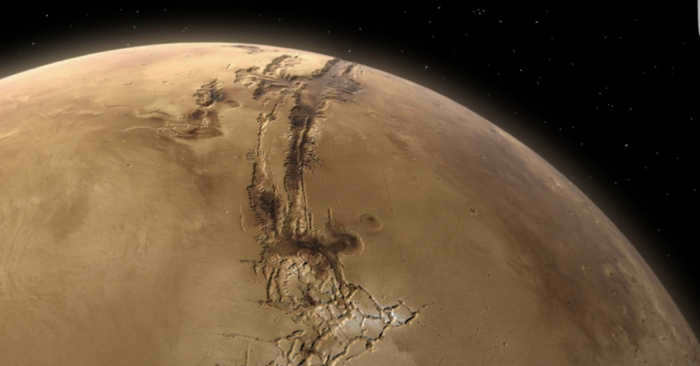
The Mariner Valley fault is a massive fault on Mars.
This fault stretches for 4,500 kilometers and reaches depths of up to 11 kilometers. To the west of the fault lies a collection of five enormous volcanoes known as the Tharsis region, with the Olympus volcano being the tallest among them.
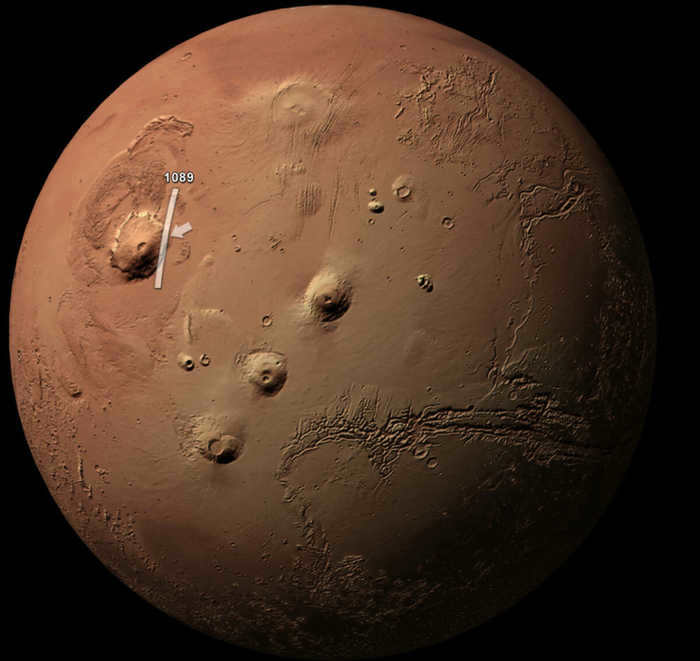

There is a line of three volcanoes on Mars, similar to the arrangement of the Hawaiian Islands on Earth. These volcanoes are Mount Askrias in the north, and Mount Peacock and Mount Arsia in the south. Their heights range from 14 to 18 kilometers. To the northeast of Olympus, there is a massive shield volcano called Alba. Although it is only 1.5 kilometers high above the plateau, its diameter spreads up to 1300 kilometers. The magma on this volcano does not spread easily due to its high viscosity, suggesting that it may be a mud volcano that has been spreading mud flows. Unlike typical basaltic cones, this volcano itself is not black in color.
The height of Olympus volcano is 26 kilometers. Mars has a total of 20 volcanoes, with five of them being massive shield volcanoes characterized by a large diameter at the base.
These volcanoes are found in a region on Mars known as the Tharsis and Forcida provinces, which are elevated compared to the surrounding surface.
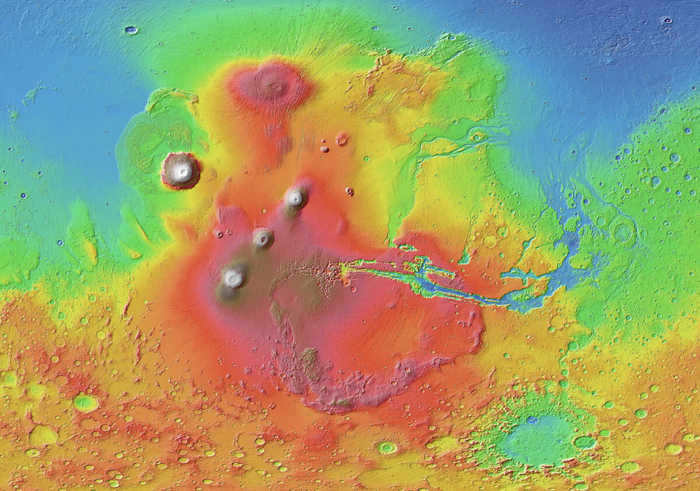
Elevation map of this hemisphere of Mars. Evidence of past flowing streams can be observed, believed to have originated from the Tharsis Province. These mountains may have been mud volcanoes, with the Tharsis Plateau consisting of sedimentary deposits. It is thought that a massive Martian flood occurred, with water flowing down below.
If the internal structures of terrestrial planets are similar, it is possible that similar events occurred on Earth, leaving behind traces and volcanoes.
The volcano Olympus has steep slopes reaching up to 7 kilometers at its base. If it had erupted lava or mud, the slopes would not have been so steep, as the masses would have flowed away. Scientists have varying opinions on this matter.
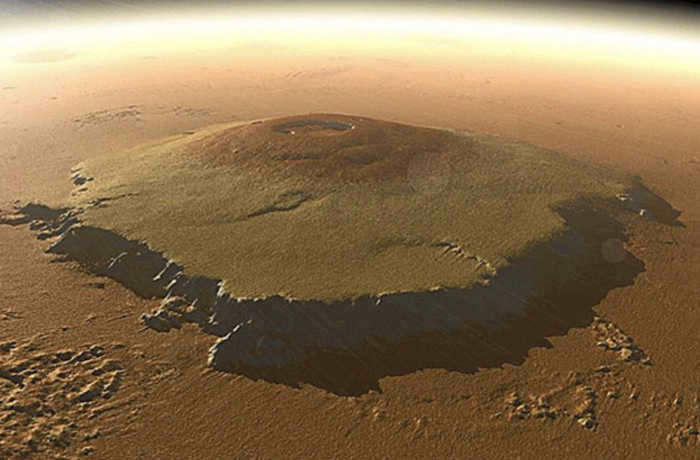
However, it has been suggested that the volcano on Mars was eroded by the ocean, causing water to wash up its slopes and create these steep cliffs. Alternatively, it is possible that streams from the Tharsis region flowed down and washed the base of Olympus Mons, without any volcanic activity occurring at that time.
In 2020, a study was published suggesting that the water channels on Mars were formed by mud volcanoes. This could be seen as supporting evidence for the mud hypothesis. Interestingly, scientists seem hesitant to apply the same reasoning to Earth.
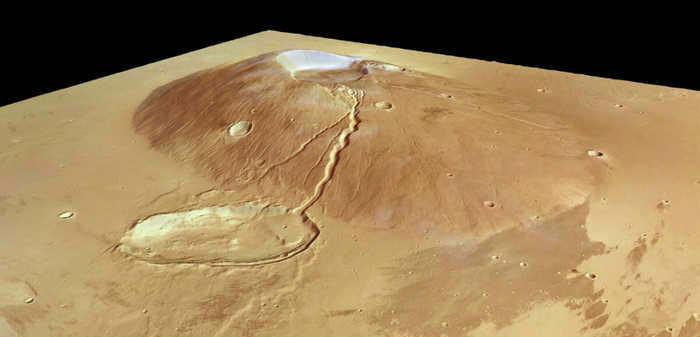
However, what could have caused such a massive event? If we direct our attention to the hemisphere opposite the volcanic plateau, we will observe an enormous depression:
One possibility is that a large celestial body collided with Mars. It is plausible that there was another moon orbiting Mars alongside Phobos and Deimos. The impact would have sent shockwaves throughout the entire planet, causing the crust on the opposite side to fracture and leading to the formation of the Mariner Valley and the giant volcanoes.
Currently, there is no evidence of large-scale volcanic activity on Mars, and it is believed that the water on the planet has evaporated, possibly due to the loss of its atmosphere. Moreover, there are no signs of life on Mars. However, there are indications that certain processes are still occurring.
Photographs taken by the AMS, a spacecraft that studied the Martian surface, show plumes emanating from the planet’s volcanoes. It is unclear whether these plumes are clouds or volcanic ash resulting from eruptions.
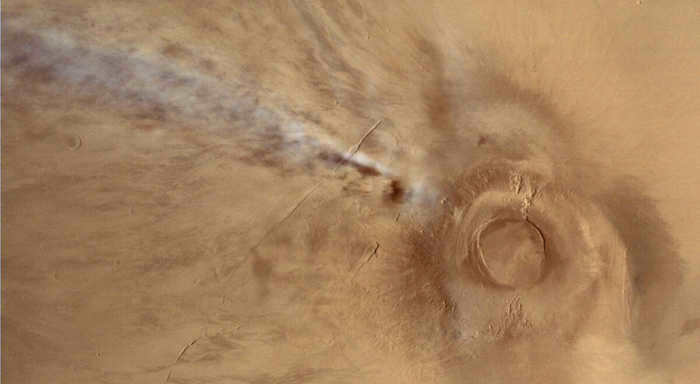
A plume originating from the Arsia volcano was first observed by the AMS Mars Express in 2018. This phenomenon had previously been documented in 2009, 2012, and 2015, suggesting that it is a recurring event. These formations are believed to be clouds that form prior to the onset of the Martian winter at these latitudes.
Scientists have determined that these clouds consist of water vapor, and their source can be traced back to the Arsia volcano. It is theorized that the release of hot gas from the volcano leads to the condensation of water vapor, resulting in the formation of these clouds. Furthermore, the size of this plume is quite significant, spanning over a thousand kilometers. Interestingly, in 2020, similar clouds were once again observed above the volcanoes.
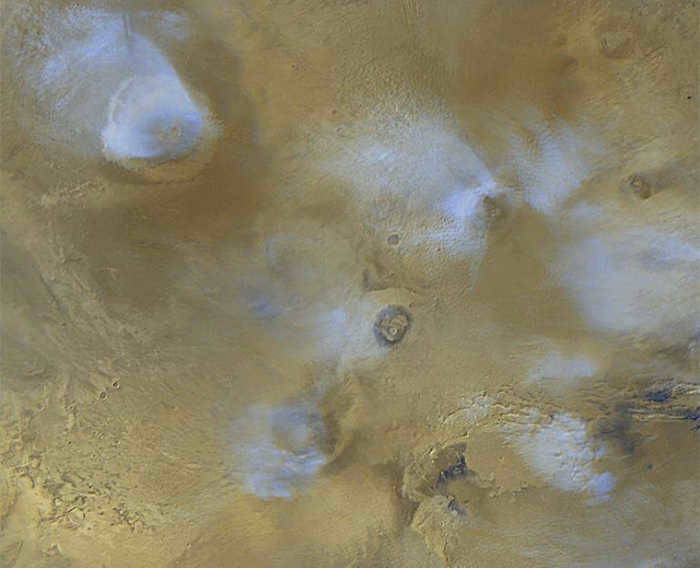
Scientists have observed that clouds tend to form simultaneously once every 687 days.
Just for comparison, here’s an image of a volcanic eruption on Earth as seen from space:
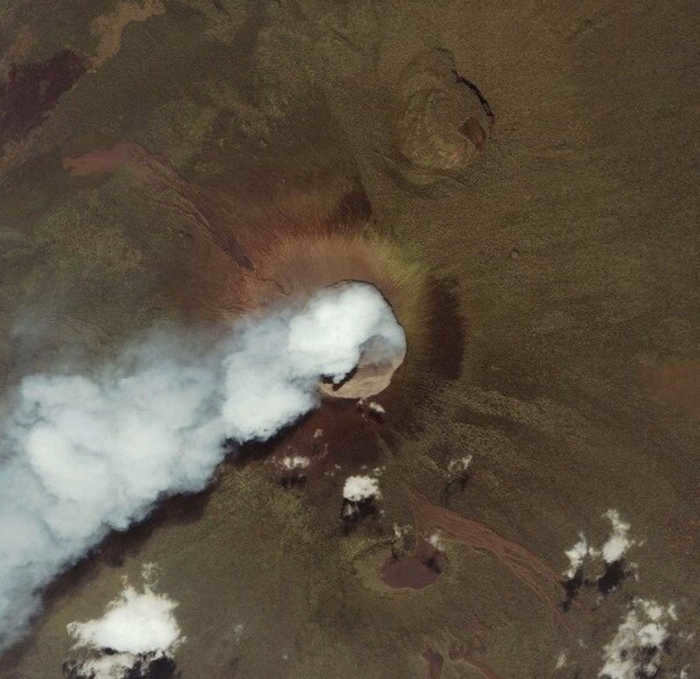
In addition to vapor, this volcano also emits ash, resembling clouds.
Incidentally, the Arsia volcano is also intriguing due to the discovery of caves on its slopes:
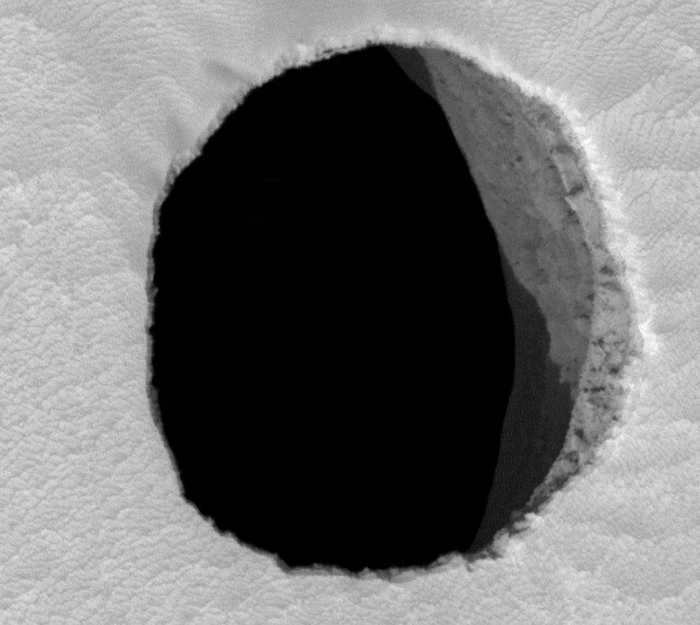

The collapse of the vaults in one of the caves is reminiscent of similar incidents on Earth, which are attributed to geothermal water outcrops. The release of pressure from the inner masses caused the formation of these caves.
Another intriguing fact that suggests ongoing processes and degassing in the depths of Mars is the discovery made by the Curiosity rover in 2019: an increase in oxygen concentration.
The gas analyzer composition data indicates that the level of oxygen increases by 30% during the spring season and remains constant until the Martian autumn. Afterward, it gradually decreases and returns to its original values. A similar pattern is observed with methane in the Gale Crater, where its normal concentration is 0.00000004% of the total volume. However, during the summer months, it experiences a significant surge of 60%.
This phenomenon can be compared to the behavior of certain biological organisms, which seem to start producing oxygen and methane during spring and then hibernate during the cold autumn months. Unfortunately, the Mars rover is not equipped with the necessary instruments to analyze and search for organic compounds, so it cannot verify this hypothesis.
One possible explanation could be that the soil is thawing (releasing the CO2 that was trapped in it as ice) and the gases that were present in the soil when Mars had a dense atmosphere are starting to escape. As a result, their concentration is increasing above the surface.
Naturally, we would prefer to believe the first scenario, that there is still some form of life remaining on Mars, even if it’s just bacteria or microscopic organisms like algae or lichens that can produce oxygen. If the atmosphere returns to Mars, it could potentially revive the biosphere in some way.
Enjoyed the article? Then check out my Telegram channel about space “Space is Near” (where all the action is happening). Plus, we will soon be hosting a space poster giveaway there!

On August 8, 2023, at 09:24 PM, Venus will be visible in the sky.
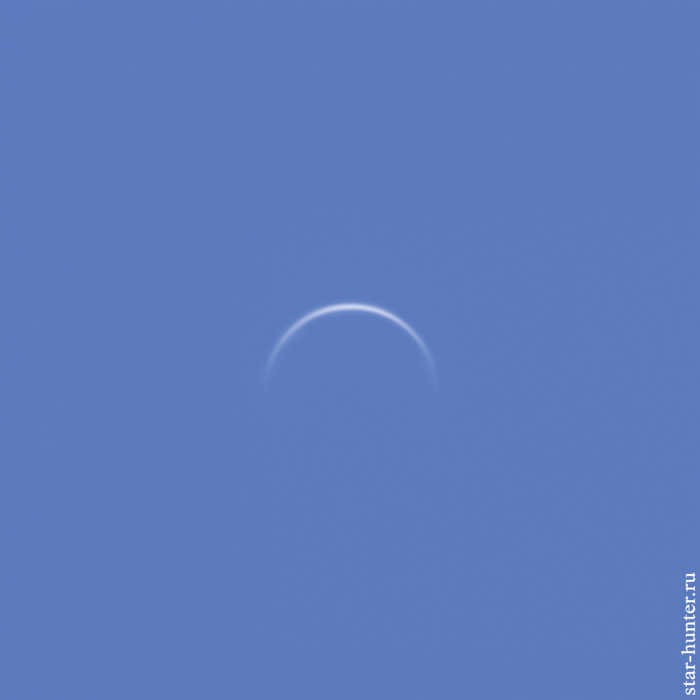
Equipment used for capturing this image included the Levenhuk Ra R66 ED Doublet Black telescope, the Sky-Watcher AZ-GTi mount, the Barlow NPZ PAG 3-5x lensblock, the ZWO ADC atmospheric dispersion corrector, the ZWO IR-cut light filter, and the ZWO 183MC astrocamera. The photo was taken at the Caucasus Mountain Observatory of the Moscow State University, located in the Karachay-Cherkessia Republic.
Individuals frequently misplace items on a regular basis, whether it be keys, glasses, or money. It is not typical to suspect vast celestial bodies of exhibiting similar callousness. Humanity has been observing these objects for thousands of years and appears to have not noticed any such behavior. Yet, there are numerous indications that certain planets within our solar system have, at certain points in time, lost satellites that once orbited around them.
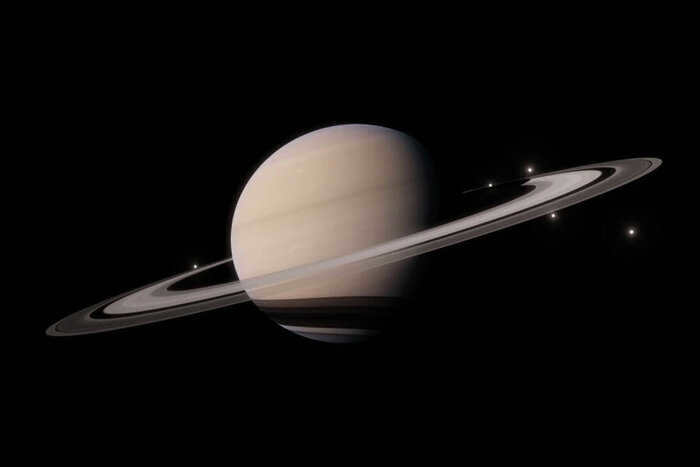

An artist’s depiction shows the Cassini spacecraft soaring above the magnificent rings of Saturn
As the rings primarily consist of ice, it is expected that they will gradually diminish over time, accumulating more and more dust particles. Thus, the rings’ age can be determined by the weight of this material, with heavier debris indicating a greater age. Data obtained from the Cassini mission has revealed that the rings are only a few tens of millions of years old. The question remains, why did they form relatively late? In 2022, a team of astronomers proposed an intriguing theory, suggesting that these rings are the remnants of a former moon of Saturn that ventured too close to the planet and disintegrated into countless small fragments.
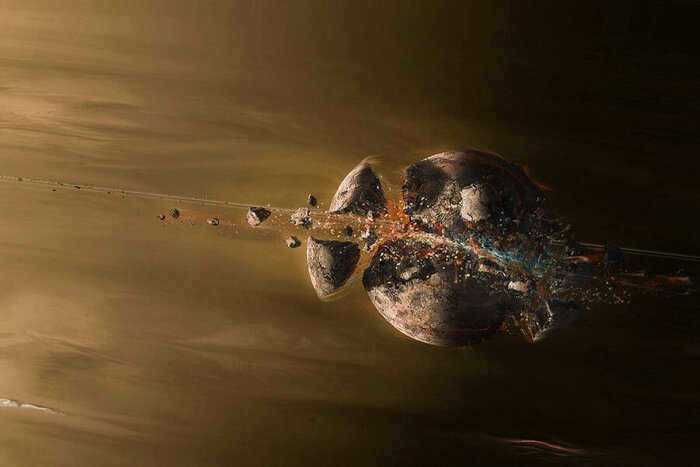

Saturn without its rings and the hypothetical satellite Chrysalis in the artist’s interpretation
Let’s shift our focus a bit closer to the Sun and discuss Jupiter. This colossal planet seems to have lost a significant number of its satellites over time. Currently, there are 95, but billions of years ago, there were even more. If the satellite near Saturn met a dramatic fate, these companions were likely engulfed by the planet. By utilizing computer simulations to recreate the early history of our solar system, astronomers have come to this somber conclusion. They input an estimation of the necessary matter to form Jupiter and its present satellites, which includes the Galilean moons Ganymede, Callisto, Io, and Europa. These moons alone account for over 99% of the mass orbiting this gas giant.
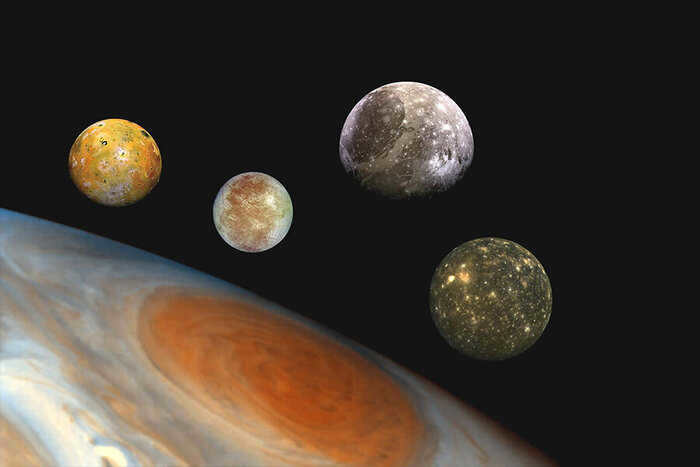
The outcome of the digital experiment turned out to be rather unexpected. It was discovered that there was enough material at the time to create at least four additional complete sets of “Galilean moons” near Jupiter. It is evident that computer simulations are not entirely accurate, especially when discussing events that occurred billions of years ago. However, some experts propose that these satellites may have indeed formed during that distant period and even explained the factors that led to their demise.
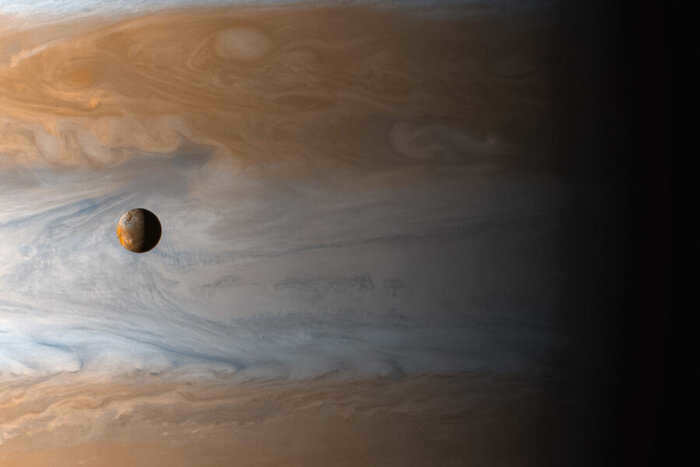
The Cassini interplanetary station provides a unique perspective on Jupiter’s satellite Io
Scientists suggest that these celestial bodies met their demise due to excessive growth. As they accumulated a significant amount of building material, their mass increased to unsustainable levels. Consequently, their velocity diminished, ultimately succumbing to the gravitational pull of the colossal planet. Eventually, they entered a death spiral and were absorbed by Jupiter. This gradual process unfolded over millions of years during the planet’s formation, resulting in the potential demise of numerous satellites. According to this theory, Galileo’s moons represent the last surviving generation, as they lacked the necessary material to reach critical mass.
When it comes to the gas giants, the Earth group planets may have a lower number of moons, but that doesn’t mean they were any less significant. Mars, for example, has two small moons orbiting it, Phobos and Deimos, which are named after Greek deities. The origin of these moons has been a subject of debate among astronomers for a long time. One theory suggests that they formed near Mars, while another proposes that they were actually asteroids that strayed too far from their intended belt and got captured by the Red Planet.
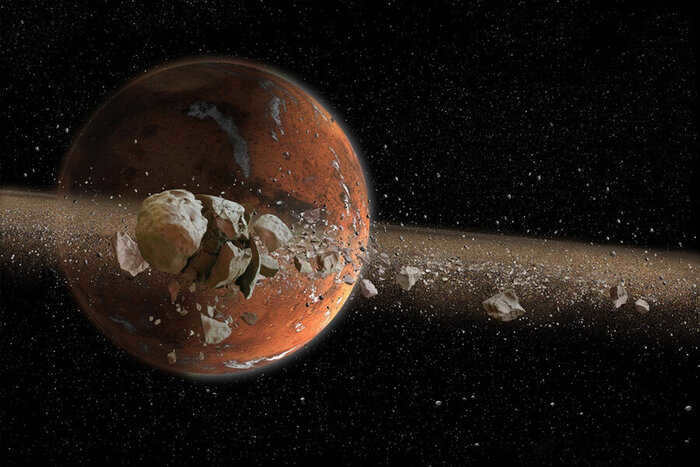
In 2021, a hypothesis was put forward by a team of scientists suggesting that Mars may have captured a solitary asteroid measuring approximately 30 kilometers in diameter between 1 and 2.7 billion years ago. This asteroid subsequently fragmented, giving rise to the formation of Phobos and Deimos. However, a year later, other scientists criticized this publication, as they conducted computer simulations and discovered evident flaws in the proposed scenario. According to their calculations, if Phobos and Deimos had formed from the fragmentation of a larger object, they would have rapidly disintegrated into a much larger amount of debris.
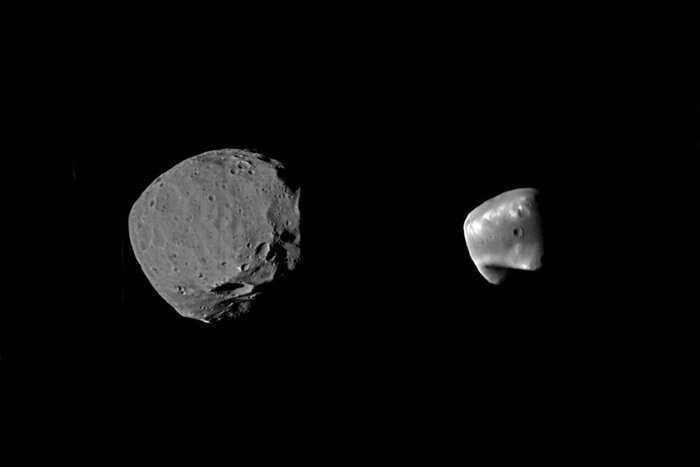
This is where the article concludes. Below are my thoughts on Picaboo (and more).
Hey there! I recently joined Picaboo and prior to that, I didn’t know much about this community. I was pleasantly surprised when my posts started getting thousands of views within the first few days. And to top it off, my article was even featured in the official Vkontakte group of Peekaboo. The engagement from readers was equally surprising. You guys didn’t hold back on the “pluses” and actively commented on my posts. Thank you!
I plan to become more active in developing my Peekaboo page and gradually make it my main platform. The reason is that I’ve been working on building my channel on Zen for almost three years now. Although I have over 50,000 subscribers there, the “wonderful” recommendation system only allows my articles to reach 100-150 reads. Additionally, Zen changed their monetization system in August, causing my channel’s income to drop to only 200 rubles per day. Given these circumstances, I believe there is no longer any reason to stay on this platform. Therefore, if you have an interest in space and everything related to it, I invite you to join our group on Peekaboo. You can expect much more interesting and informative content there!
Life on Mercury – Exploring the possibility of life on the planet Mercury.
Mercury, the Earth-group planet, has a gravitational force similar to that of Mars. Nevertheless, it holds the distinction of being the planet closest to the Sun. Its temperature varies greatly, ranging from -173 °C at night to +427 °C during the day. This extreme heat is due to the planet’s slow rotation on its axis, resulting in a day lasting 59 Earth days. Additionally, Mercury has an incredibly thin atmosphere.
Despite these harsh conditions, water ice has been discovered at the planet’s poles. Comets colliding with Mercury’s surface cause the water to vaporize, which then freezes in the polar regions. These frozen water deposits are found in deep craters that are constantly in shadow, shielded from the Sun’s heat.
Although some scientists in the late 19th century entertained the possibility of life on Mercury, our expanding knowledge of the planet leads us to conclude that either no life exists there, or at most, it would be limited to microbial forms.
This potential presence of microbial life has the ability to exist below the surface where circumstances are more advantageous [2] [3] [4].
As an illustration, the craters located at the northern pole of Mercury might possibly hold a vast amount of water ice, estimated to be between 110 billion and 1.1 trillion tons.
If the colonization of Mercury becomes a reality, it will result in the establishment of human settlements and the introduction of terrestrial organisms to certain parts of the planet. With a gravity that is only 38% of Earth’s, Mercury presents a unique opportunity for mining valuable resources such as ores, precious metals, and other raw materials. Additionally, its close proximity to the Sun grants it access to an abundant source of stellar energy, making the creation of a mining industry feasible. To ensure the safety and well-being of settlers, natural formations such as lava tubes could serve as suitable habitats, offering protection from radiation and extreme temperature fluctuations. The largest craters on Mercury, including Prokofiev, Chesterton, Kandinsky, and Tryggvadottir, ranging in size from 31 kilometers to 112 kilometers, have the potential to accommodate entire cities. By employing the concept of paraterraforming, originally proposed by English mathematician Richard Taylor in 1992, it would be possible to create a sealed environment within these craters, enabling the development of an artificial enclosed atmosphere [5].

